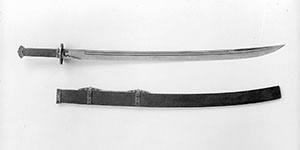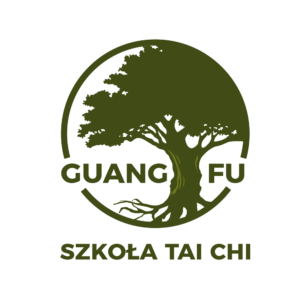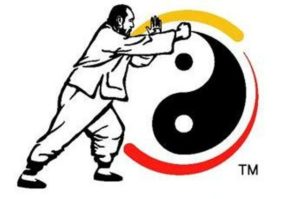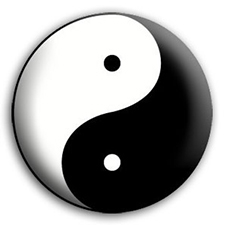Slanted FlyingJournal of Tai Chi Chuan
Training
Taiji Saber (刀 Dao)
The saber/dao (刀, sometimes called a “broadsword” and refers to a single edged sword), one of the classical short weapons of Taijiquan (太極拳), is not as commonly practiced as the sword/jian (劍, double-edged straight sword). There are several reasons for this. In Chinese culture the saber is supposed to have the quality of an enraged tiger charging down a mountain, but this fierce unyielding directness does not easily fit the calm yielding circularity associated with Taijiquan.
When correlated with the wuxing (五行 five phases), the saber is associated with metal and would traditionally be the first weapon learned since earth – correlating with the barehanded practice – produces metal. Saber techniques are considered the foundation for short weapons, and therefore the saber would be learned prior to other short weapons like the jian/sword.
This article will examine the single hand saber and not the various two handed or pole arm varieties of dao, or shorter knives. The ox-tail saber (牛尾刀 niuweidao) is the one handed saber [drawing] most commonly thought of today and was probably developed as a folk weapon in the early 1800’s. It has a flared and upward curving tip.

The military regulation dao most commonly used for Taijiquan were called a goose-quill saber (雁毛刀 yanmaodao) or a gently curved willow-leaf saber (柳葉刀 liuyedao). Both maintain a fairly constant width until reaching the pointed tip [photo]. Some Yang and Wu style schools use the goose-quill saber often modified with an “S-shaped” hand guard and a longer handle (hand and a half) with a ring pommel.

Taiji forms often use the ox-tail and goose-quill (or willow-leaf) sabers almost interchangeably, with different schools using one or the other style saber for nearly identical forms, although there are some differences that affect their usage. The goose-quill saber retains its thrusting ability fairly well even though it has a slight curvature to the blade at the distal third of its length. The curvature and the flared tip of the ox-tail saber make it less suitable for thrusting, and it typically has an angled handle in order to help in retaining some thrusting ability. The decreased thrusting ability of the ox-tail saber is less important against unarmored opponents where powerful chops and slashes can be effectively used.
Ox-tail sabers would traditionally weigh about 1 kg or more (2-3 pounds) and typically be about 30 to 39 inches long. The goose-quill saber of a similar length would traditionally weigh perhaps 25% less than an ox-tail saber. Both would have a balance point about 6-8 inches beyond where the handle meets the hand guard. Both typically have a false back edge on the distal third of the blade (the removal of metal here reduces weight and improves the balance) although this is sometimes sharpened into a true back edge. Fullers (sometimes called “blood grooves”) are commonly used to reduce the blade weight and improve the balance, especially on ox-tail sabers.
If the saber usage is fierce, unyielding and direct, how can practitioners use it in a more internal way that conforms more to Taijiquan’s calm yielding circularity? From a theoretical perspective, metal is represented by a yang line over a yin line, and this implies the ability to change. Actual metal needed to be heated and molded or hammered or otherwise manipulated and changed in order to make useful items. So even though metal is rigid, it can be manipulated and changed.
The usage of the saber in Taijiquan relies on change, beginning with one’s footwork to change angles and manipulate the distance from the opponent. Even though the saber blade is strong, Taiji saber only infrequently uses “hard” blocks against an opponent’s weapon unless the block is against the wooden shaft of a long weapon like a spear. Taiji saber instead typically uses footwork to evade the attack, and the blade typically does not touch an opponent’s saber, or only deflects it with glancing contact or “soft” parries or slides.
When “hard” blocks are needed, the back of the saber is used when possible, or the thicker part of the blade near the hand guard is used. While edge to edge contact is avoided when possible, sometimes it will accidentally happen when attacking with a powerful chop or slash and the momentum of one’s saber cannot be changed to avoid a block from an opponent’s weapon edge.
The momentum of a powerfully swung saber is something that needs to be considered. Fortunately the dull back of the saber allows for several techniques that can be used for control since the non-weapon arm or the body can contact this non-sharp edge. Wrapping and coiling around the head (缠头裹脑 chan tou guo nao) as well as wrapping the body (裹身 guo shen) and “washing” with the saber (洗刀 xi dao) are characteristic movements that can control the momentum of the saber and change directions. One movement should flow into the next.
While the momentum from a powerful sweeping or slashing attack can carry one’s saber to the side and away from an engagement with an opponent, the techniques that bring the saber around the body can bring the saber back into a defensive or offensive position. Additionally, the wielder can spin around after slashing in order to manage the momentum of the saber and to bring it back into action.
These are characteristic ways used to control the momentum of powerful saber techniques. There are other methods which are also used that are beyond the scope of this short article using verbal descriptions, like leading with the pommel into a chop (producing significant forward momentum rather than mainly downward momentum from the chop), etc.
While some schools do not contact the body while performing these movements, practitioners who do contact the body will find that the momentum of the weapon can be controlled by doing so. The momentum in one direction can be stopped by letting the dull back edge contact the body; or power can be added to the technique by using the arm or body for leverage to spring the saber off of, or to push against the dull back edge. Pushing the back edge with the non-weapon hand or arm also allows one to quickly change the saber from a defensive blocking action into an action that angles the tip toward an opponent for counterattacking.













